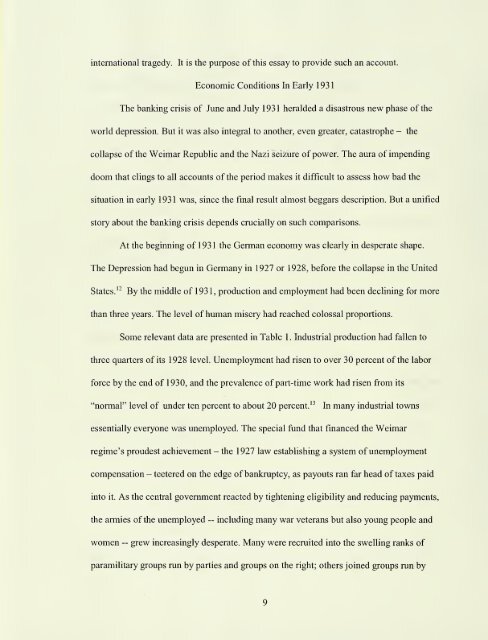Made in Germany : the German currency crisis of July 1931
Made in Germany : the German currency crisis of July 1931
Made in Germany : the German currency crisis of July 1931
Create successful ePaper yourself
Turn your PDF publications into a flip-book with our unique Google optimized e-Paper software.
<strong>in</strong>ternational tragedy. It is <strong>the</strong> purpose <strong>of</strong> this essay to provide such an account.<br />
Economic Conditions In Early <strong>1931</strong><br />
The bank<strong>in</strong>g <strong>crisis</strong> <strong>of</strong> June and <strong>July</strong> <strong>1931</strong> heralded a disastrous new phase <strong>of</strong> <strong>the</strong><br />
world depression. But it was also <strong>in</strong>tegral to ano<strong>the</strong>r, even greater, catastrophe - <strong>the</strong><br />
collapse <strong>of</strong> <strong>the</strong> Weimar Republic and <strong>the</strong> Nazi seizure <strong>of</strong> power. The aura <strong>of</strong> impend<strong>in</strong>g<br />
doom that cl<strong>in</strong>gs to all accounts <strong>of</strong> <strong>the</strong> period makes it difficult to assess how bad <strong>the</strong><br />
situation <strong>in</strong> early <strong>1931</strong> was, s<strong>in</strong>ce <strong>the</strong> f<strong>in</strong>al result almost beggars description. But a unified<br />
story about <strong>the</strong> bank<strong>in</strong>g <strong>crisis</strong> depends crucially on such comparisons.<br />
At <strong>the</strong> beg<strong>in</strong>n<strong>in</strong>g <strong>of</strong> <strong>1931</strong> <strong>the</strong> <strong>German</strong> economy was clearly <strong>in</strong> desperate shape.<br />
The Depression had begun <strong>in</strong> <strong><strong>German</strong>y</strong> <strong>in</strong> 1927 or 1928, before <strong>the</strong> collapse <strong>in</strong> <strong>the</strong> United<br />
States. 12 By <strong>the</strong> middle <strong>of</strong> <strong>1931</strong>, production and employment had been decl<strong>in</strong><strong>in</strong>g for more<br />
than three years. The level <strong>of</strong> human misery had reached colossal proportions.<br />
Some relevant data are presented <strong>in</strong> Table 1 . Industrial production had fallen to<br />
three quarters <strong>of</strong> its 1928 level. Unemployment had risen to over 30 percent <strong>of</strong> <strong>the</strong> labor<br />
force by <strong>the</strong> end <strong>of</strong> 1930, and <strong>the</strong> prevalence <strong>of</strong> part-time work had risen from its<br />
"normal" level <strong>of</strong> under ten percent to about 20 percent. 13<br />
In many <strong>in</strong>dustrial towns<br />
essentially everyone was unemployed. The special fund that f<strong>in</strong>anced <strong>the</strong> Weimar<br />
regime's proudest achievement - <strong>the</strong> 1927 law establish<strong>in</strong>g a system <strong>of</strong> unemployment<br />
compensation - teetered on <strong>the</strong> edge <strong>of</strong> bankruptcy, as payouts ran far head <strong>of</strong> taxes paid<br />
<strong>in</strong>to it. As <strong>the</strong> central government reacted by tighten<strong>in</strong>g eligibility and reduc<strong>in</strong>g payments,<br />
<strong>the</strong> armies <strong>of</strong> <strong>the</strong> unemployed — <strong>in</strong>clud<strong>in</strong>g many war veterans but also young people and<br />
women — grew <strong>in</strong>creas<strong>in</strong>gly desperate. Many were recruited <strong>in</strong>to <strong>the</strong> swell<strong>in</strong>g ranks <strong>of</strong><br />
paramilitary groups run by parties and groups on <strong>the</strong> right; o<strong>the</strong>rs jo<strong>in</strong>ed groups run by



